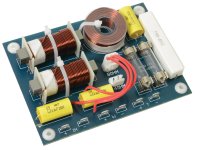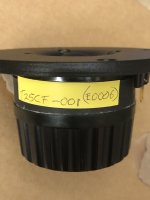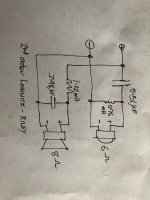I am building a 2 way speaker using the SB SATORI TW29R-B and the SATORI MW16P-4
It sounds good. People think it sounds great, There is ample bass from the speaker. But I think there should be more treble.
the crossover is at 3Khz. Should I Lower it ? 2Khz?
Wouldn't that put more emphasis on the tweeter. I am a newbie with this stuff, And when I decided to build my own speaker I had no idea how deep and complex this stuff goes.
I also have and Usher beryllium tweeter from the tiny dancer series. I dont know what that whether that would be worth swapping out. But I like the sound. Just think it could better better
Any advice from the more advanced minds out there appreciated
cheers
thanks
It sounds good. People think it sounds great, There is ample bass from the speaker. But I think there should be more treble.
the crossover is at 3Khz. Should I Lower it ? 2Khz?
Wouldn't that put more emphasis on the tweeter. I am a newbie with this stuff, And when I decided to build my own speaker I had no idea how deep and complex this stuff goes.
I also have and Usher beryllium tweeter from the tiny dancer series. I dont know what that whether that would be worth swapping out. But I like the sound. Just think it could better better
Any advice from the more advanced minds out there appreciated
cheers
thanks
Last edited by a moderator:
Can you supply the crossover schematic?
If there is an attenuating resistor in the tweeter filter then you can try lowering its value or even removing it completely in the first instance.
If there is an attenuating resistor in the tweeter filter then you can try lowering its value or even removing it completely in the first instance.
The tweeter is already 2dB more sensitive than the woofer, so, as Galu says, adjust the tweeter attenuation.
If you're a beginner, one trap to avoid is thinking that lots of treble is better - it sounds appealing initially, but ulimately is fatiguing. Getting the right balance is the key, and your ear needs to be trained to hear that.
Using this calculator : http://www.sengpielaudio.com/calculator-Lpad.htm , the ideal attenuation resistor for those speakers is 0.56 ohms
If you're a beginner, one trap to avoid is thinking that lots of treble is better - it sounds appealing initially, but ulimately is fatiguing. Getting the right balance is the key, and your ear needs to be trained to hear that.
Using this calculator : http://www.sengpielaudio.com/calculator-Lpad.htm , the ideal attenuation resistor for those speakers is 0.56 ohms
Last edited:
Hi. Thanks for your replies. Appreciated. I am a beginner in making speakers but not at listening to them. Owned a bunch of good speakers in my time. So I do think the treble is a bit lacking. As for the crossover. This is it attached photo. Some brand called QTX. I cant find any instance of the schematic.
Attachments
Hi. Thanks for your replies. Appreciated. I am a beginner in making speakers but not at listening to them. Owned a bunch of good speakers in my time. So I do think the treble is a bit lacking. As for the crossover. This is it attached photo. Some brand called QTX. I cant find any instance of the schematic.
This is the exact same driver configuration that SB Acoustics features in their ARA speaker design. Here is a link to their manual and on page 8 there is a schematic of the crossover that they designed and tested extensively.
https://sbacoustics.com/wp-content/uploads/2021/07/Ara-User-Manual.pdf
You might want to try that instead of a generic crossover that wasn't really designed for this specific driver combination. There could be a significant difference in the sound performance.
Note also that the SBA ARA cabinet is designed with a sloping front panel, so you might have to make some minor changes to the crossover if your cabinet is not sloped.
'classicalfan
Thanks. I did look at that cabinet when I was going through the process of design and researching this. but the cabinet looked extremely hard to make. And when I looked at it I thought it used the more expensive beryllium speakers. But I realise thats the BE model. Yes. I will see if I can get someone to make this. My speaker has a completely different design and possibly larger volume. I will have to calculate it. Also I note the crossover reverses the polarity of the tweeters. Why would they do that?If you use Android there's a free APP called Frequency Sound Generator that let's you finger-sweep and compare down to 1hz granularity (half-hz for bass). Within seconds you'll know the frequency response curve both overall and especially near the XO point. There should be a hump 2-4hz due to max hearing sensitivity; otherwise near flat to your hearing limit. Each tweeter axis should be aimed directly at the ear but from an angle (front-L/R) where hearing is most acute. Draw the rough FR curves free-hand, drivers together with and without the XO, and also separately (so as to compare against published charts). Then the XO could be tweaked or redesigned.
Last edited:
Unless your cabinet is significantly larger that the ARA it probably won't make that much difference. The SBA crossover could still be an advantage over the generic one that you currently use, because it was designed specifically for that set of drivers. Any cabinet volume difference will affect mainly the base extension and likely have minimum effect on crossover.
Also, it's fairly common to reverse the polarity of the tweeter to correct for the phase shift introduced by the crossover and bring both drivers back into phase with each other.
A frequent suggestion is to test the phase both ways in order to decide which way actually sounds better to you.
Also, it's fairly common to reverse the polarity of the tweeter to correct for the phase shift introduced by the crossover and bring both drivers back into phase with each other.
A frequent suggestion is to test the phase both ways in order to decide which way actually sounds better to you.
I am in the process of designing a 2 way speaker using a couple of pairs of drivers I have , considering a transmission line format.
The speakers are a SEAS T25CF-001 and an old IMF mid /bass which has a 7in cone. The SES is 6 ohm and the IMF is 8 ohm looking at a crossover of 3000hz, 2nd order Linkwitz.
have attached a crossover diagram as a starting point.
The speakers are a SEAS T25CF-001 and an old IMF mid /bass which has a 7in cone. The SES is 6 ohm and the IMF is 8 ohm looking at a crossover of 3000hz, 2nd order Linkwitz.
have attached a crossover diagram as a starting point.
Attachments
- Home
- Loudspeakers
- Multi-Way
- 2 way speaker build



